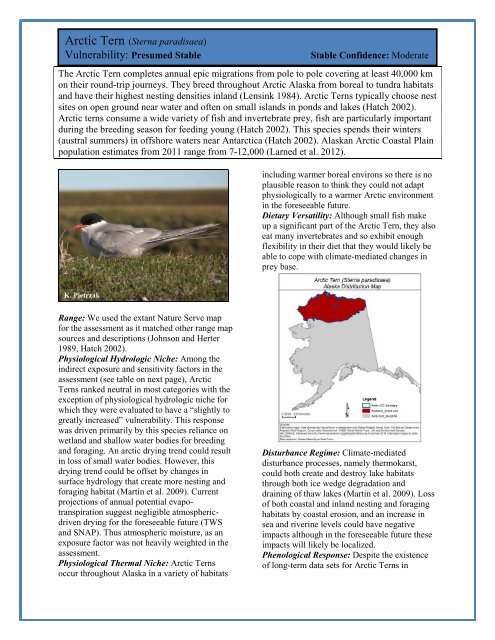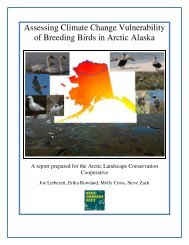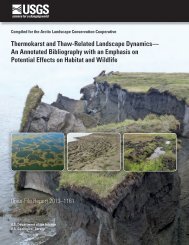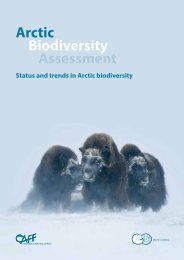Download - Arctic LCC
Download - Arctic LCC
Download - Arctic LCC
Create successful ePaper yourself
Turn your PDF publications into a flip-book with our unique Google optimized e-Paper software.
<strong>Arctic</strong> Tern (Sterna paradisaea)<br />
Vulnerability: Presumed Stable<br />
Stable Confidence: Moderate<br />
The <strong>Arctic</strong> Tern completes annual epic migrations from pole to pole covering at least 40,000 km<br />
on their round-trip journeys. They breed throughout <strong>Arctic</strong> Alaska from boreal to tundra habitats<br />
and have their highest nesting densities inland (Lensink 1984). <strong>Arctic</strong> Terns typically choose nest<br />
sites on open ground near water and often on small islands in ponds and lakes (Hatch 2002).<br />
<strong>Arctic</strong> terns consume a wide variety of fish and invertebrate prey, fish are particularly important<br />
during the breeding season for feeding young (Hatch 2002). This species spends their winters<br />
(austral summers) in offshore waters near Antarctica (Hatch 2002). Alaskan <strong>Arctic</strong> Coastal Plain<br />
population estimates from 2011 range from 7-12,000 (Larned et al. 2012).<br />
including warmer boreal environs so there is no<br />
plausible reason to think they could not adapt<br />
physiologically to a warmer <strong>Arctic</strong> environment<br />
in the foreseeable future.<br />
Dietary Versatility: Although small fish make<br />
up a significant part of the <strong>Arctic</strong> Tern, they also<br />
eat many invertebrates and so exhibit enough<br />
flexibility in their diet that they would likely be<br />
able to cope with climate-mediated changes in<br />
prey base.<br />
K. Pietrzak<br />
Range: We used the extant Nature Serve map<br />
for the assessment as it matched other range map<br />
sources and descriptions (Johnson and Herter<br />
1989, Hatch 2002).<br />
Physiological Hydrologic Niche: Among the<br />
indirect exposure and sensitivity factors in the<br />
assessment (see table on next page), <strong>Arctic</strong><br />
Terns ranked neutral in most categories with the<br />
exception of physiological hydrologic niche for<br />
which they were evaluated to have a “slightly to<br />
greatly increased” vulnerability. This response<br />
was driven primarily by this species reliance on<br />
wetland and shallow water bodies for breeding<br />
and foraging. An arctic drying trend could result<br />
in loss of small water bodies. However, this<br />
drying trend could be offset by changes in<br />
surface hydrology that create more nesting and<br />
foraging habitat (Martin et al. 2009). Current<br />
projections of annual potential evapotranspiration<br />
suggest negligible atmosphericdriven<br />
drying for the foreseeable future (TWS<br />
and SNAP). Thus atmospheric moisture, as an<br />
exposure factor was not heavily weighted in the<br />
assessment.<br />
Physiological Thermal Niche: <strong>Arctic</strong> Terns<br />
occur throughout Alaska in a variety of habitats<br />
Disturbance Regime: Climate-mediated<br />
disturbance processes, namely thermokarst,<br />
could both create and destroy lake habitats<br />
through both ice wedge degradation and<br />
draining of thaw lakes (Martin et al. 2009). Loss<br />
of both coastal and inland nesting and foraging<br />
habitats by coastal erosion, and an increase in<br />
sea and riverine levels could have negative<br />
impacts although in the foreseeable future these<br />
impacts will likely be localized.<br />
Phenological Response: Despite the existence<br />
of long-term data sets for <strong>Arctic</strong> Terns in
<strong>Arctic</strong> Tern (Sterna paradisaea)<br />
Vulnerability: Presumed Stable<br />
Stable Confidence: Moderate<br />
D=Decrease<br />
vulnerability, SD=Somewhat decrease vulnerability, N=Neutral effect, SI=Slightly increase vulnerability,<br />
I=Increase vulnerability, GI=Greatly increase vulnerability.<br />
northern Alaska (Larned et al. 2012) an<br />
assessment of phenology-related variables has<br />
not been a part of that effort or has not been<br />
examined so it is currently unknown how this<br />
species will respond to changing biotic<br />
schedules.<br />
Interactions with Other Species: Fox nest<br />
predation could increase as the availability of<br />
“island” nesting sites could be more limited if<br />
shallower ponds dry out from a region-wide<br />
tundra drying trend.<br />
In summary, the results of this vulnerability<br />
assessment indicate that the <strong>Arctic</strong> Tern will<br />
likely be adaptable enough to cope with climate<br />
change and associated habitat changes predicted<br />
to occur in <strong>Arctic</strong> Alaska, at least during the 50<br />
year timeline of this assessment.<br />
Literature Cited<br />
Hatch, J.J. 2002. <strong>Arctic</strong> Tern (Sterna paradisaea), The<br />
Birds of North America Online (A. Poole, Ed.). Ithaca:<br />
Cornell Lab of Ornithology; Retrieved from the Birds of<br />
North America Online:<br />
http://bna.birds.cornell.edu/bna/species/707<br />
doi:10.2173/bna.707<br />
Johnson, S.R. and D.R. Herter. 1989. The birds of the<br />
Beaufort Sea, Anchorage: British Petroleum Exploration<br />
(Alaska), Inc.<br />
Larned, W., R. Stehn, and R. Platte. 2012. Waterfowl<br />
breeding population survey, <strong>Arctic</strong> Coastal Plain, Alaska,<br />
2011. Unpublished Report, U.S. Fish and Wildlife Service,<br />
Anchorage, AK. 51pp.<br />
Lensink, C.J. 1984. The status and conservation of seabirds<br />
in Alaska. Pp. 13-27 in Status and conservation of the<br />
world’s seabirds. (J.P. Croxall, P.G.H. Evans, and R.W.<br />
Schreiber, eds.) International Council of Bird Preservation,<br />
Cambridge, UK.<br />
Martin, P., J. Jenkins, F.J. Adams, M.T. Jorgenson, A.C.<br />
Matz, D.C. Payer, P.E. Reynolds, A.C. Tidwell, and J.R.<br />
Zelenak. 2009. Wildlife response to environmental <strong>Arctic</strong><br />
change: Predicting future habitats of <strong>Arctic</strong> Alaska. Report<br />
of the Wildlife Response to Environmental <strong>Arctic</strong> Change<br />
(WildREACH), Predicting Future Habitats of <strong>Arctic</strong> Alaska<br />
Workshop, 17-18 November 2008. Fairbanks, Alaska,<br />
USFWS, 148 pages.<br />
The Wilderness Society (TWS) and Scenarios Network for<br />
Alaska Planning (SNAP), Projected (2001-2099: A1B<br />
scenario) monthly total potential evapotranspiration from 5<br />
AR4 GCMs that perform best across Alaska and the <strong>Arctic</strong>,<br />
utilizing 2km downscaled temperature as model inputs.<br />
http://www.snap.uaf.edu/data.php.<br />
From: Liebezeit et al. 2012. Assessing Climate Change Vulnerability of Breeding Birds in <strong>Arctic</strong> Alaska. A report prepared for the<br />
<strong>Arctic</strong> Landscape Conservation Cooperative. Wildlife Conservation Society, North America Program, Bozeman, MT., 167pp.








